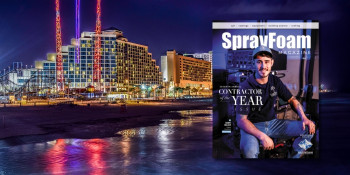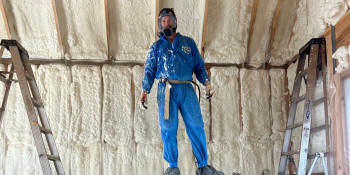Q&A Forums
Maximum thickness of closed cell Post New Topic | Post Reply
| Author | Comments |
|---|---|
|
Dave Strnad
Posted: Jul 17, 2007 10:02 PM
|
Maximum thickness of closed cell
All the 2 lb closed cell products I know of only have a E 84 rating for a thickness of up to 4 inches. Do you know of any that have been rated for more? If not what would be the legality of applying 4" of one prouduct and 2" of another. Even though both are 2 lb foam the tests are done on individual products not 2lb foam in general, correct? This seems shady, but it seems like there are a lot of grey areas in this business and nobody is addressing them. One of the local inspectors will not allow more then 4" of closed cell, but also is requiring that it meets the minimum r-38, the customer wants all closed cell foam. I have heard of guys using a closed and open combination, so what would be the difference.
|
|
mason
Posted: Jul 18, 2007 08:08 AM
|
The test apparatus that is used for ASTM E 84 typically is only capable of testing up to a thickness of 4 inches. So it is not possible in most circumstances to obtain flame spread and smoke developed numbers for greater thickness of foam plastic. The building codes state the the foam plastic must be tested in the maximum thickness intended for use in accordance with ASTM E 84. But recognizing the limitations of the apparatus, it lists exceptions to testing at the maximum thickness. Section 2603. Exception 4 of the 2006 IBC code and section 314 of the IRC allows the use of "foam plastic in thickness greater than 4 inhces when tested at a maximum thickness of 4 inches provided the end use is approved with Section 2603.9 and 314.6 respectively using the thickness and density intended for use." Section 2603.9 lists large-scale fire tests such as UL 1715, FM 4880, UL 1040 or NFPA 286 that can be used for special approval and would not require Most fire code consultants that are famililar with sprayfoam recognize that sprayfoam tested at 4 inches will have similar flame spread and smoke developed ratings at greater thickness. However, some code officials do not. Unless the manufacturer has tested an assembly with thickness greater than 4 inches, you may not be able to convince a local building code official of its safe use. But I've seldom run across a building code official who would not take the word of a reputable fire code consultant. I doubt that a building official would allow the use of two different foam plastics that combined would average more than 4 inches in maximum thickness. But, you could always get an opinion before the project starts. |





























